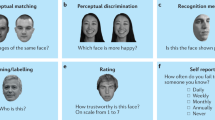Abstract
Studies based on mean accuracy of a group of subjects suggest that most observers do no better than chance in detecting the lies of others. We argue that a case-by-case methodology, like that used in polygraphy studies may be more useful. Three behavioral measures (two kinds of smiles and pitch) were used to make predictions about the lying or truthfulness of each of 31 subjects. A case-by-case analysis of the hits and misses achieved in this way yielded an over-all accuracy of 86%. The effect on lie detection accuracy of individual differences in the use and control of different behavioral channels is discussed.
Similar content being viewed by others
References
DePaulo, B.M., Stone, J.I., & Lassiter, G.D. (1985). Deceiving and detecting deceit. In B.R. Schlenker (Ed.),The self and social life (pp. 323–370). New York: McGraw-Hill.
Efron, D. (1972).Gesture, race and culture. The Hague: Mouton. (Originally published in 1941 asGesture and environment)
Ekman, P. (1985).Telling lies: Clues to deceit in the marketplace, marriage, and politics. New York: W.W. Norton.
Ekman, P. & Friesen, W. V. (1969). The repertoire of nonverbal behavior: Categories, origins, usage, and coding.Semiotica, 1, 49–98.
Ekman, P. & Friesen, W. V. (1972). Hand movements.Journal of Communication, 22, 353–374.
Ekman, P., & Friesen, W.V. (1974). Detecting deception from body or face.Journal of Personality and Social Psychology, 29, 288–298.
Ekman, P., & Friesen, W.V. (1976). Measuring facial movement.Environmental Psychology and Nonverbal Behavior, 1, 56–75.
Ekman, P., & Friesen, W. V. (1978).Facial action coding system. Palo Alto, CA: Consulting Psychologists Press.
Ekman, P., & Friesen, W.V. (1982). Felt, false and miserable smiles.Journal of Nonverbal Behavior, 6, 238–252.
Ekman, P., Friesen, W.V., & O'Sullivan, M. (1988). Smiles when lying.Journal of Personality and Social Psychology, 54, 414–420.
Ekman, P., Friesen, W.V., O'Sullivan, M., & Scherer, K. (1980). Relative importance of face, body and speech in judgments of personality and affect.Journal of Personality and Social Psychology, 38, 270–277.
Ekman, P., Friesen, W. V., & Scherer, K. (1976). Body movement and voice pitch in deceptive interaction.Semiotica, 16, 23–27.
Ekman P., & O'Sullivan, M. (In press). Who can catch a liar?American Psychologist.
Guelker, E. (1977).Grundfrequenz und Persoenlichkiet im Interaktionsprozees unter Stress. Unpublished diploma thesis, University of Giessen, West Germany.
O'Sullivan, M., Ekman, P., Friesen, W.V., & Scherer, K. (1990).Judging honest and deceptive behavior. Manuscript submitted for publication.
Saxe, L., Dougherty, D., & Cross, T. (1985). The validity of polygraph testing: Scientific analysis and public controversy.American Psychologist, 40, 355–366.
Standke, R. (1990).Vocal parameter analysis, Unpublished manuscript, University of Giessen, West Germany.
Stellmann, H. (1976). Auswirkung von Spannungssituationen auf das Stimmverhalten—Eine Untersuchung dieses Zusammenhangs anhand eines Stressinterviews. Unpublished diploma thesis, University of Giessen, West Germany.
Zuckerman, M., & Driver, R.E. (1985). Telling lies: Verbal and nonverbal correlates of deception. In A. W. Siegman & S. Feldstein (Eds.),Multichannel integration of nonverbal behavior (pp. 129–147). Hillsdale, NJ: Erlbaum.
Author information
Authors and Affiliations
Additional information
Paul Ekman's work is supported by a Research Scientist Award from the National Institute of Mental Health (MH 06092).
Rights and permissions
About this article
Cite this article
Ekman, P., O'Sullivan, M., Friesen, W.V. et al. Invited article: Face, voice, and body in detecting deceit. J Nonverbal Behav 15, 125–135 (1991). https://doi.org/10.1007/BF00998267
Issue Date:
DOI: https://doi.org/10.1007/BF00998267




